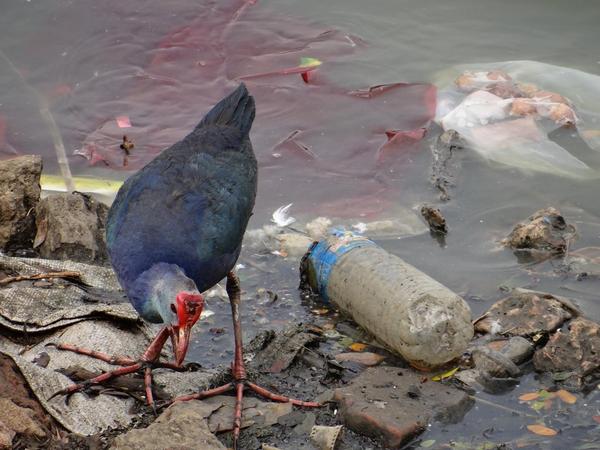
A purple moorhen feeding on litter. Pic:Anvitha
This time, I turn this column over to a friend, Anvitha, who is 17-years-old, and who is utilising her post-exam holidays to good effect, watching birds. Alas, it’s not always a thing of joy. Here’s her report from Lalbagh, in Bangalore:
The fragrance of flowers attracts bees; so do the birds in Lalbagh attract bird watchers. Birdwatchers from all corners of Bangalore have always been drawn towards Lalbagh, but today the situation has changed for the worse.
Over the years, the number of birdwatchers visiting Lalbagh has reduced due to the dwindling number of birds. This is because of littering, a colossal problem birds encounter in Lalbagh. I took this photo in Lalbagh last week.
This bird is called the Purple Moorhen or the Purple Swamphen. Purple Moorhens are birds of the size of village hens and are mostly seen on reedy swamps feeding on small insects and vegetal matter.
But as you can see, I found this bird, and others, feeding on garbage. It was an awful sight. Plastic bottles, plastic bags, tin cans and all sorts of waste lies around the lake area. The moorhen, unaware of the consequences, has peacefully adjusted to its surroundings. Research shows that consumption of litter can be fatal for animals.
We can’t afford to lose these wonderful birds. We are connected to them. We have to remember, their survival decides our survival.
We can choose not to see Lalbagh as a trash bin any longer. When we visit Lalbagh next time, let us keep in mind that we are there to enjoy its serene beauty and not destroy it. Let us not litter and ensure others don’t litter. Let’s not forget every person makes a difference. We can choose to be a part of a problem… or its solution.
Cheers, Anvitha, for those wise and cautionary words. Less litter, everyone, and let’s enjoy more birds!